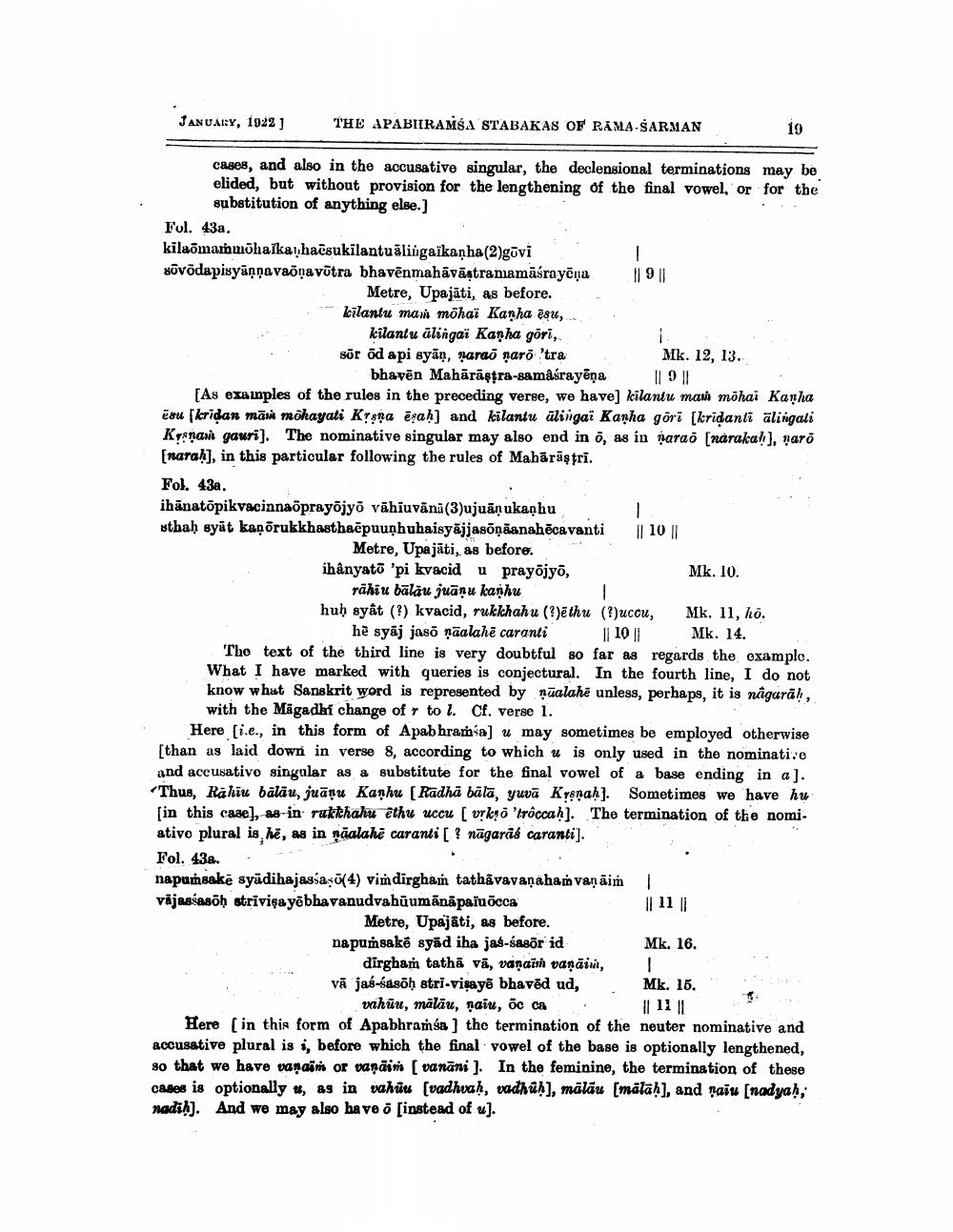________________
JANUARY, 1922]
THE APABIIRAMA STABAKAS OF RAMA-SARMAN
19
cases, and also in the accusative singular, the declensional terminations may be elided, but without provision for the lengthening of the final vowel, or for the
substitution of anything else.) Fol. 43a. kilaðmarmōhaskavhaēsukilantuāliūgaïkaņha(2)gūvi sūvõdapisyāņpavaõnavõtra bhavēnmahāvā tramamā rayona
Metre, Upajāti, as before. kilantu man möhai Kanha esu,
kilantu ūlingai Kanha gori, sõr od api syān, narao naro 'tra
Mk. 12, 13. bhavēn Mahārā tra-samasrayēņa | 9 | [As examples of the rules in the preceding verse, we have) kilantu man möhai Kanha Esu [keridan māsas möhayali Krana @yah] and kilantu alingai Kanha göri [kridandi alingali Kynasil gauri). The nominative singular may also end in 7, as in narao (narakah], "aro [narah], in this particular following the rules of Mahārās tri. Fol. 43a. ihanatopikvacinnaõprayõjyo vāhiuvānū(3)ujuāņukaņhu sthah syāt kaņõrukkhasthaēpuunhuhaisyājjasõņāanahēcavanti || 10 ||
Metre, Upajāti, as before. ihânyato 'pi kvacid u prayõjyo,
Mk. 10. rāhiu bālāu juāņu karhu huh syat (?) kvacid, rukkhahu (?)ēthu (?)uccu, Mk. 11, hö.
hè syāj jaso ņāalahē caranti | 10 | Mk. 14. The text of the third line is very doubtful so far as regards the example. What I have marked with queries is conjectural. In the fourth line, I do not know what Sanskrit word is represented by nūalahē unless, perhaps, it is nagarāh,
with the Magadhí change of r to l. Cf. verse 1.
Here [i.e., in this form of Apab hram a) u may sometimes be employed otherwise [than as laid down in verse 8, according to which u is only used in the nominati.e and accusative singular as a substitute for the final vowel of a base ending in a). Thus, Rahiu balāu, juāņu Karhu (Radha bālā, yuvā Kysnah]. Sometimes we have hu [in this case), as-in: rukthahu ethu uccu ( vrkso 'trôccah]. The termination of the nomi. ativo plural is hë, as in ņāalahi caranti [ ? nāgaras caranti]. Fol. 43a. . napumsakë syūdihajassa (4) vimdirgha tathāvavanaham vanail väjassasõh striviçayēbhavanudvabūumānäpaiuöcca
Metre, Upajāti, as before. napuṁsakê syād iha jas-sasör id
Mk. 16. dirgham tathā vă, vanaish vaņāinit, vā jas-sasőh stri-visayē bhavőd ud, Mk. 15.
vahữu, mālāu, naiu, öc ca . 1111 Here (in this form of Apabhramsa) the termination of the neuter nominative and accusative plural is i before which the final vowel of the base is optionally lengthened, so that we have vanaim or vaņāim ( vanāni). In the feminine, the termination of these cases is optionally #, as in vahiu (vadhvah, vadhúh), mālāu (mālāh), and raiu [nadyah, nadih). And we may also have 7 [instead of u).




